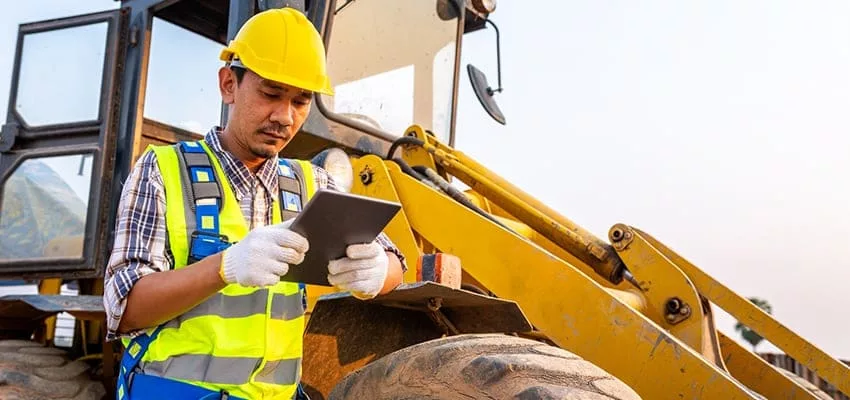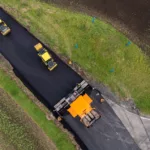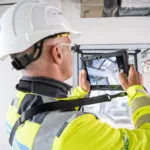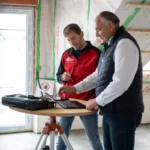Efficiency, overview – and more freedom for your team through integrated device management
Digital tools do make your construction company more efficient. But it’s the integrated interaction of your software solutions that really gets you ahead. Jan Köster, product manager at 123onsite, explains why it makes sense to integrate your device management into your jobsite software.
In the
digitization of the construction industry
companies can benefit from the experience of other industries. It quickly becomes apparent that digitization is more than just innovative software applications such as a
digital Construction diary
for your
construction site management
. The intelligent networking of machines and processes with the aid of IT, as exemplified by Industry 4.0, is particularly exciting for the construction sector. The topic has been circulating for several years, but now the technologies that were promised at the time are actually being lived.
The topic of Industry 4.0 is now gradually reaching the construction sector.
The networking of machines and software brings efficiency gains through automation from which construction companies can benefit. The prerequisite: a system in which all software solutions are integrated.
This is what digital device management brings you
With a
equipment management software
you have an overview of your fleet at all times – at a glance on a map. You see immediately: Where exactly are your machines? Is the correct Equipment located with the appropriate projects? When did an Equipment leave the project again? GPS tracking allows you to see all this in real time.
You can also follow a step-by-step history of where your Equipment has been used, what it has done, and how much idle time it has had. The
fleet management
supports your planning and automates your data collection.
That’s why you should integrate your device management into your building software
If your device management is integrated with the rest of your software solution, you can automatically combine all data sets. You thus have an intelligent linking of your master and capture data from different sources. All your operations will benefit from this:
You can manage Staff and Equipment at the same time
Equipment in use always needs a person to operate the machine. For your planning, it therefore makes sense if the software solutions work together. For example, you can coordinate your vehicle drivers much more efficiently and see at a glance: When can Staff and Equipment be scheduled where?
If all applications access a common database, you can quickly see what permissions individual employees have
You also see: Who is allowed to drive the desired Equipment at all? Are there employees on site who are authorized to operate the Equipment? You can also store documents for all equipment in the system: Vehicle registration documents, TÜV and maintenance reports, and operating manuals are not stored in folders in the office, but can be conveniently accessed online. Your drivers will also always have access to all documents.
You keep track of maintenance and TÜV appointments for your machines
Maintenance is also much more efficient with integrated fleet management. You can plan repairs and maintenance much better – and prevent machines from being on the job site not ready for use. Does your equipment support predictive maintenance? Then the next maintenance task is automatically displayed and you can optimize your scheduling. Because if the maintenance is forgotten, it can cause major problems. The Employer’s Liability Insurance Association asks whether a particular piece of Equipment has even been to the TÜV? Or your TÜV has expired? This can be expensive. At the latest then, the financial added value of a device management system becomes clear.
You avoid idling and can optimize your fleet size
Equipment management helps you prevent idling and use unused machines more efficiently. The evaluation also gives you a good data basis for your future planning. Maybe you’ll need fewer rental vehicles in the future? This definitely saves costs. Over time, this will give you an estimate for your ideal fleet size.
You work more efficiently and save time
Working with an integrated system, helps you,
manage construction equipment efficiently
.

The advantages of your integrated software solution
In your daily work with an integrated software system, not only your team will be happy about simplified processes. The work becomes much more efficient. This has many advantages for you and your team:
A common database for all programs
Nothing is more time-consuming than having to constantly log in again. In an integrated system, on the other hand, you work with only one login.
A single login for all applications
Nothing is more time consuming than having to constantly log in again. In an integrated system, on the other hand, you work with only one login.
Real time view
Everyone who accesses the system always sees data and information in the most up-to-date form possible.
You have an integrated view of the overall process (process transparency)
You have your projects with all details clearly arranged in one system.
Working in only one system makes your processes more efficient
Your team will work more efficiently if they know the system really well. After a quick familiarization with the user interface, the tricks of the system are quickly adopted in everyday work.
Cost savings through only one provider
Do you keep track of all your license agreements and know when to update? With a software solution from a single source, you save time and nerves – and money. Just try it out.
The software works reliably and is constantly kept up to date
With an integrated system, you have a single point of contact for all software questions. The system is always up to date and there are no compatibility problems.
We have a new update every two weeks and make sure everything is working. With integrated software, you know: it just works.
Photo credits: GregorBister/E+ via Getty Images; Pramote Polyamate/Moment via Getty Images








